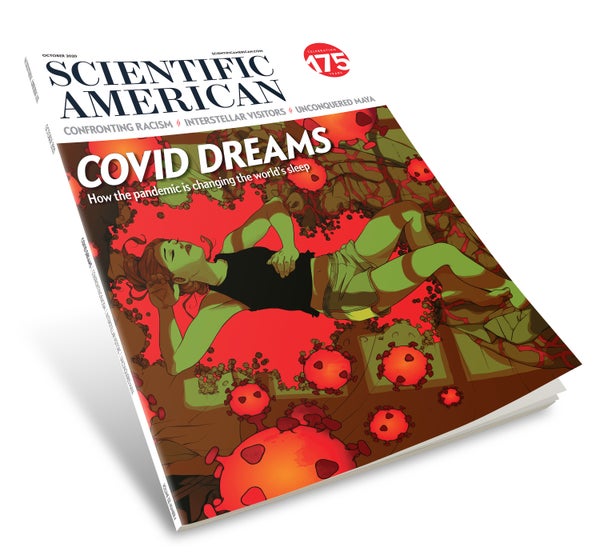Have you been sleeping well this year? If not, you're not alone. Nightmares about COVID-19—fears of being in crowded spaces, touching germy surfaces, feeling exposed without a mask—have been disturbing the sleep of people around the world. The pandemic seems to have introduced a new shared unreality, with dreams that are as alarming as that one about being late for a final exam you haven't studied for. Our cover story this month is from psychiatrist and dream researcher Tore Nielsen, who is busy studying the largest inadvertent sleep-disruption experiment in history.
COVID-19 is the worst pandemic in a century, in part because the coronavirus behaves in unexpected ways. At first, we thought the disease spread primarily through sneezes and coughs and from people touching surfaces where respiratory droplets had landed. Now we know the virus spreads through the air, often from people who don't have symptoms and don't realize they're infected. Asymptomatic transmission is one of the ways the new pandemic resembles the HIV/AIDS pandemic, and longtime researcher William A. Haseltine shares lessons for COVID-19 from the early days of AIDS. One of his more touching observations is that there is a social element to both diseases. People go to bars and parties when they are seeking companionship, which is natural and human.
When a bizarre object zipped through our solar system in late 2017, astronomers quickly realized it was from out of this world. ‘Oumuamua is the first object from another solar system to be detected in ours. We call it an object because nobody really knows what it is—it's kind of comet-ey, kind of asteroid-ey, and according to a few theorists, it's not entirely unlike an alien ship. (In general, whenever somebody says, “Maybe it's aliens,” it's never aliens.) A second extrasolar interloper soon followed, and astronomers David Jewitt and Amaya Moro-Martín, among others, are eagerly anticipating the next ones.
The COVID-19 pandemic is exacerbating the health effects of racism, with disproportionate illness and deaths among people of color. Janet Currie, an expert on social and environmental impacts on health, explains how infants can be unequal at birth. One hopeful side of her article is that access to health care and nutritional support, as well as other interventions and policies, can and do improve the health of babies born at a disadvantage, leading to dramatic improvements in lifelong health and economic security.
The story on unlearning racism shows one person's struggle, using science and scholarship, to understand and confront the bias we're pickled in. A lot of people are newly recognizing systemic inequalities in the U.S. and other parts of the world, and we hope writer Abigail Libers's story and the books she recommends will help.
People who live in the forests around Lake Mensabak in the southern Mexican state of Chiapas are descendants of the Lacandon Maya, a group that left the large cities of the Maya empire when drought, war, slavery and disease devastated the civilization. Now modern Lacandon Maya are collaborating with archaeologists to study their history and understand how their ancestors adapted to a new life. Freelance writer Zach Zorich takes us there.
When people move, dance, sing or swing together, they often experience a distinct form of joy and fellowship. Writer Marta Zaraska shares the social science and brain science of synchrony, which some researchers claim has a social-bonding function that helped early humans form cohesive groups (and make beautiful music together).
Thank you for reading Scientific American. All of us here wish you good health and pleasant (or as pleasant as possible) dreams.
